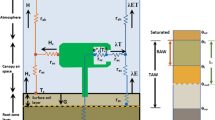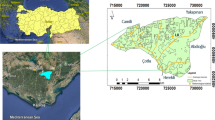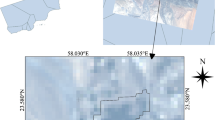Abstract
Water shortages in the Western United States will continue to be one of the foremost American agricultural challenges in the coming years. As agriculture is the largest consumer of water in the western US, improvements in irrigation scheduling and modeling are needed to maximize production under limited water. Various satellite-based remote sensing models have been developed to estimate crop water use. However, water balance-based evapotranspiration (ET) models need field-scale irrigation information for initiating the seasonal soil water balance. This initialization has been challenging due to the lack of remotely sensed irrigation event data. In this study, we utilized a recently launched satellite constellation (Planet) with high temporal and spatial resolution data (daily, ~ 3 m) to evaluate if Planet data can facilitate early season irrigation detection. We utilized normalized difference vegetation index (NDVI), moisture index, and individual spectral bands to detect moisture and ultimately infer irrigation. As part of this comparison, a hybrid two-source energy and water balance model BAITSSS (Backward-Averaged Iterative Two-Source Surface temperature and energy balance Solution) was used to estimate ET with Planet-based vegetation indices and irrigation information. We also compared the results to eddy covariance (EC) located at lettuce fields in Yuma, Arizona in the lower Colorado River basin between 2016 and 2020. Overall, the results indicated that Planet’s data helped to establish the field-scale onset of irrigation, which assisted to initiate soil water balance in the BAITSSS model, thus ultimately improving ET. Further, these results should support the development of near-real-time landscape-scale ET and should be highly beneficial to agricultural communities for sub-field-scale effective water management.








Similar content being viewed by others
Data availability
Weather data can be found (https://ag.arizona.edu/azmet/). We thank the United States Department of Agriculture (USDA) Agricultural Research Service (ARS) and the University of Arizona for providing the Eddy Covariance data.
References
Alexander GA, Holmes HA, Sun X et al (2022) Simulating land-atmosphere coupling in the Central Valley, California: investigating soil moisture impacts on boundary layer properties. Agric For Meteorol 317:108898. https://doi.org/10.1016/j.agrformet.2022.108898
Allen RG, Tasumi M, Trezza R (2007) Satellite-based energy balance for mapping evapotranspiration with internalized calibration (METRIC)—model. J Irrig Drain Eng 133:380–394
Anderson MC, Norman JM, Mecikalski JR et al (2007) A climatological study of evapotranspiration and moisture stress across the continental United States based on thermal remote sensing: 1. Model formulation. J Geophys Res Atmos 112(D10). https://doi.org/10.1029/2006JD007506
Anderson MC, Kustas WP, Alfieri JG et al (2012) Mapping daily evapotranspiration at Landsat spatial scales during the BEAREX’08 field campaign. Adv Water Resour 50:162–177. https://doi.org/10.1016/j.advwatres.2012.06.005
Aragon B, Houborg R, Tu K et al (2018) CubeSats enable high spatiotemporal retrievals of crop-water use for precision agriculture. Remote Sens 10:1867
Arguez A, Durre I, Applequist S et al (2012) NOAA’s 1981–2010 U.S. climate normals: an overview. Bull Am Meteorol Soc 93:1687–1697. https://doi.org/10.1175/BAMS-D-11-00197.1
Bastiaanssen WGM, Menenti M, Feddes RA, Holtslag AAM (1998) A remote sensing surface energy balance algorithm for land (SEBAL). 1. Formulation. J Hydrol 212–213:198–212. https://doi.org/10.1016/S0022-1694(98)00253-4
Bazzi H, Baghdadi N, Najem S et al (2022) Detecting irrigation events over semi-arid and temperate climatic areas using sentinel-1 data: case of several summer crops. Agronomy 12:2725. https://doi.org/10.3390/agronomy12112725
Bhatti S, Heeren DM, O’Shaughnessy SA et al (2022) Comparison of stationary and mobile canopy sensing systems for maize and soybean in Nebraska, USA. Appl Eng Agric 38:331–342
Chen Y, Marek GW, Marek TH et al (2018) Improving SWAT auto-irrigation functions for simulating agricultural irrigation management using long-term lysimeter field data. Environ Model Softw 99:25–38. https://doi.org/10.1016/j.envsoft.2017.09.013
Cheng Y, Vrieling A, Fava F et al (2020) Phenology of short vegetation cycles in a Kenyan rangeland from PlanetScope and Sentinel-2. Remote Sens Environ 248:112004
Dhungel R, Allen RG, Trezza R, Robison CW (2016) Evapotranspiration between satellite overpasses: methodology and case study in agricultural dominant semi-arid areas: Time integration of evapotranspiration. Met Apps 23:714–730. https://doi.org/10.1002/met.1596
Dhungel R, Aiken R, Colaizzi PD et al (2019a) Evaluation of uncalibrated energy balance model (BAITSSS) for estimating evapotranspiration in a semiarid, advective climate. Hydrol Process 33:2110–2130. https://doi.org/10.1002/hyp.13458
Dhungel R, Aiken R, Lin X et al (2019) Restricted water allocations: landscape-scale energy balance simulations and adjustments in agricultural water applications. Agric Water Manage 227:105854
Dhungel R, Anderson RG, French AN et al (2022) Assessing evapotranspiration in a lettuce crop with a two-source energy balance model. Irrig Sci 41:183–196
Dhungel R, Anderson RG, French AN et al (2023) Remote sensing-based energy balance for lettuce in an arid environment: influence of management scenarios on irrigation and evapotranspiration modeling. Irrig Sci. https://doi.org/10.1007/s00271-023-00848-9
Dupigny-Giroux L-A, Lewis JE (1999) A moisture index for surface characterization over a semiarid area. Photogramm Eng Remote Sens 65:937–946
Fisher J (2022) Emerging technology for daily, field-scale, global evapotranspiration from space. In EGU General Assembly Conference Abstracts (pp. EGU22-3223)
Fisher JB, Tu KP, Baldocchi DD (2008) Global estimates of the land–atmosphere water flux based on monthly AVHRR and ISLSCP-II data, validated at 16 FLUXNET sites. Remote Sens Environ 112:901–919. https://doi.org/10.1016/j.rse.2007.06.025
French AN, Hunsaker DJ, Sanchez CA et al (2020) Satellite-based NDVI crop coefficients and evapotranspiration with eddy covariance validation for multiple durum wheat fields in the US Southwest. Agric Water Manage 239:106266. https://doi.org/10.1016/j.agwat.2020.106266
Gašparović M, Medak D, Pilaš I et al (2018) Fusion of Sentinel-2 and planetscope imagery for vegetation detection and monitoring. Int Arch Photogramm Remote Sens Spatial Inf Sci 42:155–160
Gutman G, Ignatov A (1998) The derivation of the green vegetation fraction from NOAA/AVHRR data for use in numerical weather prediction models. Int J Remote Sens 19:1533–1543. https://doi.org/10.1080/014311698215333
Haq MA (2021) Intelligent sustainable agricultural water practice using multi sensor spatiotemporal evolution. Environ Technol. https://doi.org/10.1080/09593330.2021.2005151
Hassan-Esfahani L, Torres-Rua A, Jensen A, McKee M (2015) Assessment of surface soil moisture using high-resolution multi-spectral imagery and artificial neural networks. Remote Sens 7:2627–2646
Houborg R, McCabe MF (2018) Daily Retrieval of NDVI and LAI at 3 m Resolution via the fusion of CubeSat, Landsat, and MODIS data. Remote Sens 10:890
Hu MQ, Mao F, Sun H, Hou YY (2011) Study of normalized difference vegetation index variation and its correlation with climate factors in the three-river-source region. Int J Appl Earth Obs Geoinf 13:24–33. https://doi.org/10.1016/j.jag.2010.06.003
Huckleberry JK, Potts MD (2019) Constraints to implementing the food-energy-water nexus concept: governance in the lower Colorado River Basin. Environ Sci Policy 92:289–298
Ihuoma SO, Madramootoo CA, Kalacska M (2021) Integration of satellite imagery and in situ soil moisture data for estimating irrigation water requirements. Int J Appl Earth Observ Geoinf 102:102396. https://doi.org/10.1016/j.jag.2021.102396
Jarvis PG (1976) The interpretation of the variations in leaf water potential and stomatal conductance found in canopies in the field. Phil Trans R Soc Lond B 273:593–610. https://doi.org/10.1098/rstb.1976.0035
Kington J, Collison A (2022) scene level normalization and harmonization of planet dove imagery. https://assets.planet.com/docs/scene_level_normalization_of_planet_dove_imagery.pdf. Accessed 23 Jan 2023
Knapp KR, Frouin R, Kondragunta S, Prados A (2005) Toward aerosol optical depth retrievals over land from GOES visible radiances: determining surface reflectance. Int J Remote Sens 26:4097–4116. https://doi.org/10.1080/01431160500099329
Marek GW, Gowda PH, Marek TH et al (2017) Modeling long-term water use of irrigated cropping rotations in the Texas High Plains using SWAT. Irrig Sci 35:111–123. https://doi.org/10.1007/s00271-016-0524-6
Massari C, Modanesi S, Dari J et al (2021) A review of irrigation information retrievals from space and their utility for users. Remote Sens 13:4112. https://doi.org/10.3390/rs13204112
Melton FS, Huntington J, Grimm R et al (2021) Openet: filling a critical data gap in water management for the western United States. JAWRA J Am Water Resour Assoc 58:971–994
Morris B, Dupigny-Giroux L (2010) Using the Nir/blue surface moisture index to explore feature identification at multiple spatial resolutions. In: AGU fall meeting abstracts, pp H23F-1298
Olivera-Guerra L, Merlin O, Er-Raki S (2020) Irrigation retrieval from Landsat optical/thermal data integrated into a crop water balance model: a case study over winter wheat fields in a semi-arid region. Remote Sens Environ 239:111627. https://doi.org/10.1016/j.rse.2019.111627
Rösch M, Sonnenschein R, Buchelt S, Ullmann T (2022) Comparing PlanetScope and Sentinel-2 imagery for mapping Mountain Pines in the Sarntal Alps, Italy. Remote Sens 14:3190. https://doi.org/10.3390/rs14133190
Sanchez CA, Zerihun D, Farrell-Poe KL (2009) Management guidelines for efficient irrigation of vegetables using closed-end level furrows. Agric Water Manage 96:43–52. https://doi.org/10.1016/j.agwat.2008.06.010
Santos DL, Coelho EF, de Oliveira RA et al (2021) Impact of soil water regimes and partial root-zone drying in field-grown papaya in semi-arid conditions. Sci Rep 11:10638. https://doi.org/10.1038/s41598-021-90078-w
Senay GB, Bohms S, Singh RK et al (2013) Operational evapotranspiration mapping using remote sensing and weather datasets: a new parameterization for the SSEB approach. J Am Water Resour Assoc 49:577–591. https://doi.org/10.1111/jawr.12057
Su Z (2002) The surface energy balance system (SEBS) for estimation of turbulent heat fluxes. Hydrol Earth Syst Sci 6:85–100. https://doi.org/10.5194/hess-6-85-2002
Sullivan A, White DD, Hanemann M (2019) Designing collaborative governance: insights from the drought contingency planning process for the lower Colorado River basin. Environ Sci Policy 91:39–49
Taghvaeian S, Andales AA, Allen LN et al (2020) Irrigation scheduling for agriculture in the United States: the progress made and the path forward. Trans ASABE 63:1603–1618. https://doi.org/10.13031/trans.14110
Vermote E, Justice C, Csiszar I (2014) Early evaluation of the VIIRS calibration, cloud mask and surface reflectance Earth data records. Remote Sens Environ 148:134–145. https://doi.org/10.1016/j.rse.2014.03.028
Wang X, Xie H, Guan H, Zhou X (2007) Different responses of MODIS-derived NDVI to root-zone soil moisture in semi-arid and humid regions. J Hydrol 340:12–24. https://doi.org/10.1016/j.jhydrol.2007.03.022
Wieczorek M (2014) Area- and depth- weighted averages of selected SSURGO variables for the conterminous United States and District of Columbia. U.S. Geological Survey, Reston, VA. https://scholar.google.com/scholar_lookup?title=Area-%20and%20depth-%20weighted%20averages%20of%20selected%20SSURGO%20variables%20for%20the%20conterminous%20United%20States%20and%20District%20of%20Columbia&doi=10.3133%2Fds866&
www.planet.com P https://www.planet.com/. In: Planet. https://www.planet.com/. Accessed 14 Nov 2022
York AM, Eakin H, Bausch JC et al (2020) Agricultural water governance in the desert: shifting risks in central Arizona. Water Alternat 13:418–445
Zappa L, Schlaffer S, Bauer-Marschallinger B et al (2021) Detection and quantification of irrigation water amounts at 500 m using Sentinel-1 surface soil moisture. Remote Sens 13:1727. https://doi.org/10.3390/rs13091727
Acknowledgements
This work is supported by Agriculture and Food Research Initiative Competitive Grant no. 2020-69012-31914 from the USDA National Institute of Food and Agriculture. This research was supported in part by the U.S. Department of Agriculture, Agricultural Research Service (project numbers 2036-61000-018-000-D and 2020-13660-008-000-D). This research used resources provided by the SCINet project of the USDA Agricultural Research Service, ARS (project number 0500-00093-001-00-D). The U.S. Department of Agriculture prohibits discrimination in all its programs and activities on the basis of race, color, national origin, age, disability, and where applicable, sex, marital status, familial status, parental status, religion, sexual orientation, genetic information, political beliefs, reprisal, or because all or part of an individual’s income is derived from any public assistance program (Not all prohibited bases apply to all programs). Persons with disabilities who require alternative means for communication of program information (Braille, large print, audiotape, etc.) should contact USDA’s TARGET Center at (202) 720-2600 (voice and TDD). To file a complaint of discrimination, write to USDA, Director, Office of Civil Rights, 1400 Independence Avenue, S.W., Washington, D.C. 20250-9410, or call (800) 795-3272 (voice) or (202) 720-6382 (TDD). USDA is an equal opportunity provider and employer.
Author information
Authors and Affiliations
Contributions
RD, RGA, AF, and TS designed and performed research, analyzed data, and originated manuscript; TS, MS and CAS contributed data; ES guided project development. All authors reviewed and revised the manuscript.
Corresponding author
Ethics declarations
Conflict of interest
The authors declare no conflicts of interest relevant to this study.
Additional information
Publisher's Note
Springer Nature remains neutral with regard to jurisdictional claims in published maps and institutional affiliations.
Rights and permissions
About this article
Cite this article
Dhungel, R., Anderson, R.G., French, A.N. et al. Early season irrigation detection and evapotranspiration modeling of winter vegetables based on Planet satellite using water and energy balance algorithm in lower Colorado basin. Irrig Sci 42, 15–27 (2024). https://doi.org/10.1007/s00271-023-00874-7
Received:
Accepted:
Published:
Issue Date:
DOI: https://doi.org/10.1007/s00271-023-00874-7




